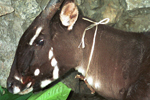The Vietnam government and local people have approved a Saola Natural Reserve to protect one of the world’s most endangered—and most elusive—mammals. Only discovered by the outside world in 1992, the saola (Pseudoryx nghetinhensis) inhabits the lush forests of the Annamite Mountains. No one knows how many saola remain, but it has been classified as Critically Endangered as it is likely very few. Recently, conservationist William Robichaud told mongabay.com that the saola was “perhaps the most spectacular zoological discovery of the 20th century”, comparing it only to the discovery of the okapi in central Africa in 1900.
The new reserve in Quang Nam Province rests on the border of Vietnam and Laos.
“This new reserve will create a biodiversity corridor connecting the East of Vietnam to West side of Xe Sap National Park in Laos,” explained Ms. Tran Minh Hien, Country Director of WWF Vietnam, in a statement.
There are no specimens of saola in zoos, making reintroduction impossible should the species go extinct in the wild. Over a dozen individual saolas have been held in captivity, but all died within a few months time.
While the saola looks like an Africa antelope, it is actually more closely related to wild cattle, though it is evolutionary unique enough to have its own genus. The saola’s range extends along the Annamite Mountains in both Vietnam and Laos. The animal is threatened by snares set by poachers, dog-hunting, and loss of habitat largely exacerbated by road construction.
Related articles
The saola: rushing to save the most ‘spectacular zoological discovery’ of the 20th Century

(04/04/2011) The saola (Pseudoryx nghetinhensis) may be the most enigmatic, beautiful, and endangered big mammal in the world—that no one has ever heard of. The shy ungulate looks like an African antelope—perhaps inhabiting the wide deserts of the Sahara—but instead it lives in the dense jungles of Vietnam and Laos, and is more related to wild cattle than Africa’s antelopes. The saola is so unusual that is has been given its own genus: Pseudoryx, due to its superficial similarities to Africa’s oryx. In the company of humans this quiet forest dweller acts calm and tame, but has yet to survive captivity long. Yet strangest of all, the 200 pound (90 kilogram) animal remained wholly unknown to science until 1992.
Vietnam implements project to save one of the world’s rarest mammals, the shy soala

(02/24/2010) Vietnam’s central province of Thua Thien-Hue has approved a project to save the enigmatic saola. Listed as Critically Endangered, the saola (Pseudoryx nghetinhensis)—a type of forest antelope—is so rare and secretive that it was only discovered in 1992. It is considered by many to be one of the world’s rarest mammals. The project, funded by the Darwin Initiative, Cambridge University, and WWF, will be largely carried out by forest rangers during the next 33 months in Bach Ma National Park and a saola preservation zone. The project includes research, raising public awareness, and managing the protected areas to help the saola’s survival.
Last chance to save a ‘singular beauty’ of Asia: the shy soala

(09/03/2009) Only discovered in 1992, the reclusive and beautiful saola Pseudoryx nghetinhensis may soon vanish from the Earth, if rapid action isn’t taken to save one of Asia’s most enigmatic and rare mammals. Listed as Critically Endangered, the species has experienced a sharp decline since its discovery due largely to poaching. “The animal’s prominent white facial markings and long tapering horns lend it a singular beauty, and its reclusive habits in the wet forests of the Annamites an air of mystery,” says Barney Long, of the IUCN Asian Wild Cattle Specialist Group.